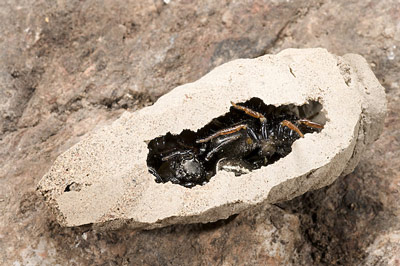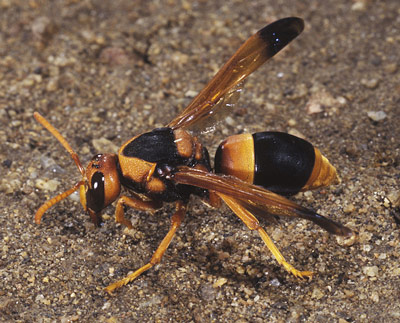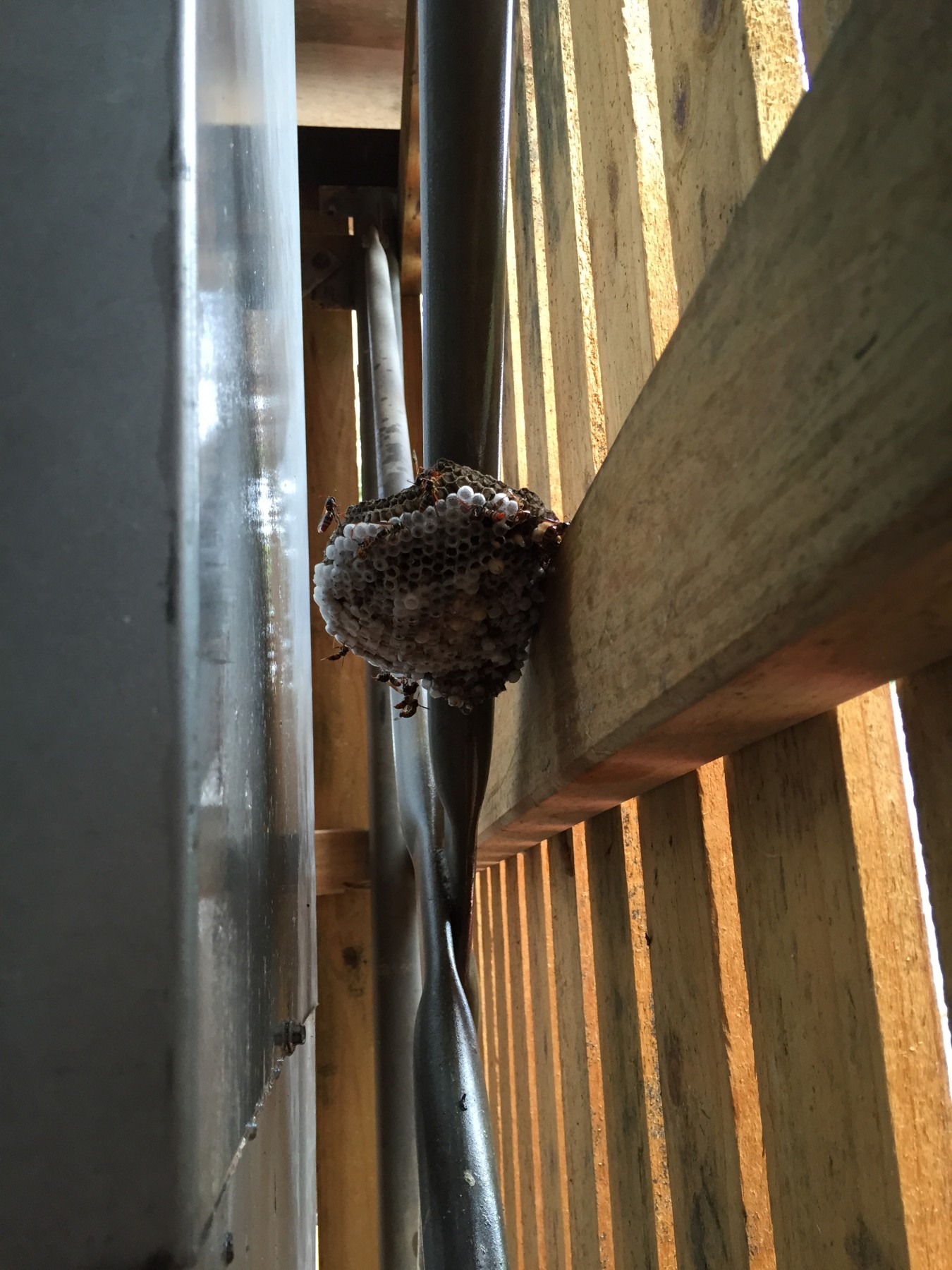WASPS
Paper Wasps
The strings of paper wasp nests hanging from the eave of an old Queenslander or from a rusty barbed wire fence are a typical part of Australia. Most of us have, at one time,blundered into them and run blindly through the bush pursued by their angry owners. However, the attacks by paper wasps are all in the cause of home security and most stings are received near their nests. Away from the nests, they rarely attack and stings are usually the result of a wasp becoming entangled in clothing or being accidentally grasped. Paper wasps make their nests by chewing weathered wood and mixing it with saliva. This soft material is formed into the required shape with their jaws and it dries to a stiff, papery form. A nest consists of a number of cup-like cells, grouped together to form a comb. The comb is attached to a surface such as a branch, twig or rock face by one or more stalks or peduncles. There are several different species of paper wasps and each has a distinctive nest design.
Biology
In spring, new nests are started by one or several females that have been inactive through the colder months, resting in cracks and crevices. Paper wasps, like ants and some bees, are social insects, meaning each nest consists of a cooperative colony of females. Only one female, the queen, lays all the eggs. The reproduction of all the other females in the colony is suppressed and the workers are responsible for feeding the young and maintaining and enlarging the nest. Unlike honeybees, the queen of Australian paper wasps is very similar in appearance to the workers. She lays an egg in the bottom of each empty cell. When the wasp grubs or larvae hatch they are fed with chewed up caterpillars collected by the workers. When the larvae are fully grown, the workers close up the cell with a pale-coloured cap of papery material. The larvae turn into pupae within the cells and some time later new adult wasps emerge and remain with the colony. In this way the nests expand in size as summer progresses. As the weather cools the colony produces male wasps These mate with the females who then find sheltered places in which to spend the winter. Those females that survive the colder months begin new colonies in spring.
How many paper wasps?
Australia has about 35 native species of paper wasps ranging from 8 to 26 mm in length and patterned in yellow, brown and black, often with a banded abdomen. Paper wasps are unusual in having their front pairs of wings folded lengthwise when they are not in use. This distinguishes them from other wasps except potter wasps, a group that uses mud rather than paper as their nest-building material. Our native paper wasps belong to two groups or genera, Polistes and Ropalidia. Native paper wasps are found throughout Australia excluding Tasmania and the southwestern corner of Western Australia although this area has two introduced species of Polistes. Tropical Queensland has the most species of paper wasp in Australia. Australia also has two introduced species of European paper wasps belonging to a third genus, Vespula.
Polistes
Paper wasps belonging to this genus are usually larger than species of Ropalidia and the first segment of the abdomen following the waist is generally broader and evenly merges into the rest of the abdomen.
All species of Polistes build nests of a similar type. They consist of a single circular or subcircular comb with a central or slightly offset point of attachment or penduncle. The nest
is never surrounded by a papery envelope. The mushroomshaped nests, commonly suspended from the eaves of houses, are built by several species of Polistes. These wasps, which include P. humilis and P. stigma in Brisbane, are medium to large in size with a yellow, brown, and sometimes black colour pattern. P. schach is larger and almost completely reddishbrown. It builds large combs in hollow trees and fallen logs.
Polistes humilis nest
Ropalidia
Species of Ropalidia are usually smaller than Polistes and the first segment of the abdomen following the waist is generally more slender and distinctly narrower than the following
segment.
Ropalidia revolutionalis is a small to medium sized, dark reddish-brown wasp, very common from south-eastern to northern Queensland. It builds very distinctive nests that are
frequently found on garden shrubs or fences. Each comb consists of a vertical strip two cells wide, attached by a peduncle at the upper end. Large colonies of this species may
be made up of a row of several combs. Another common but less noticed species is Ropalidia romandi, a small, yellowish wasp with dark-brown markings. It builds a nest of several combs stacked upon each other and covered by a thin, papery outer envelope. In northern Queensland its nests are medium-sized and normally attached to the foliage of trees but in south-eastern Queensland the nests may be huge, sometimes over a metre long. They are normally attached to the underside of the branches of large trees especially eucalypts. When the trees shed their bark the nests fall to the ground. The wasps immediately abandon the fallen nest and build a new nest. Occasionally this species builds on the walls
and eaves of houses.
Ropalidia revolutionalis Ropalidia romandi
Mud Dauber and Potter wasps
Many species of predatory wasps build nests from a mixture of mud and saliva. Many are large, conspicuous, black and yellow or black and orange wasps. Mud dauber wasps fill their nest cells with paralysed spiders as a food source for their larvae. Potter wasps fill them with paralysed caterpillars.
Mud dauber wasp
Sceliphron laetum
Identification
Length to 28 mm. The elongated body is mostly black with yellow patches. The characteristic waist is long and thread-like.Females build mud nests in sheltered situations such as caves, overhangs or even inside buildings. The Individual cells of the nest are flask-shaped and placed in rows. Nests consist of up to three tiers of cells covered with extra layers of mud. The cells are filled with many spiders as food for the larvae. The wasp emits a high-pitched buzz while manipulating mud at the nest. They are found across mainland Australia and in New Guinea and nearby islands. Sceliphron formosum is a similar species whose nest has only one layer of cells and is not covered with extra mud.



Female Mud Dauber wasp Mud Dauber wasp nest with spider Mud Dauding wasp nest
Potter Wasp
Abispa ephippium
Identification
Length to 30 mm. A robust, mostly orange wasp with a large central black patch between the forewings, a wide black band on the abdomen and orange wings with black tips. Female potter wasps build large mud nests with many cells in sheltered positions. The cells are filled with caterpillars as food for the larvae. They build a temporary entrance funnel while the cells are being filled. The females search for prey around trees and shrubs and use their jaws to cut into the shelters of caterpillars that conceal themselves in rolls of leaves. This species is found across Australia.


Female Potter wasp Female Potter wasp at work on garage door
* Information and various photographs used with permission of The Queensland Museum











